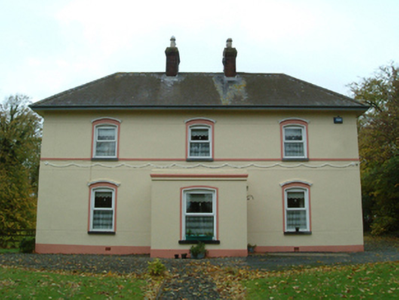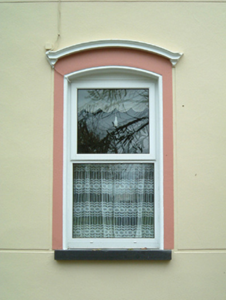Survey Data
Reg No
12304008
Rating
Regional
Categories of Special Interest
Architectural, Artistic, Historical, Social
Original Use
Presbytery/parochial/curate's house
In Use As
Presbytery/parochial/curate's house
Date
1843 - 1900
Coordinates
228343, 163526
Date Recorded
19/05/2004
Date Updated
--/--/--
Description
Detached three-bay two-storey presbytery, extant 1900, on an F-shaped plan centred on single-bay single-storey flat-roofed projecting porch to ground floor; single-bay (west) or two-bay (east) two-storey side elevations centred on single-bay (single-bay deep) full-height central return (north). Occupied, 1901; 1911. Refenestrated, ----. Hipped slate roof on an F-shaped plan with clay ridge tiles, paired red brick Running bond central chimney stacks having corbelled stepped capping supporting yellow terracotta tapered pots, and cast-iron rainwater goods on timber eaves boards on slightly overhanging eaves retaining cast-iron downpipes. Rendered walls on inscribed rendered flush base with inscribed rendered flush piers to ends. Square-headed window opening in camber-headed recess (porch) with cut-limestone sill, and rendered flush surround having bull nose-detailed reveals framing replacement uPVC casement window replacing timber sash window. Square-headed window openings in camber-headed recesses with cut-limestone sills, and rendered flush surrounds having bull nose-detailed reveals with hood mouldings framing replacement uPVC casement windows replacing timber sash windows. Set back from street in landscaped grounds with rendered piers to perimeter having concrete capping.
Appraisal
A presbytery representing an integral component of the built heritage of Urlingford with the architectural value of the composition suggested by such attributes as the compact plan form centred on an expressed porch; and the diminishing in scale of the openings on each floor producing a graduated visual impression with those openings showing sleek "stucco" refinements. Having been well maintained, the elementary form and massing survive intact together with substantial quantities of the original fabric, both to the exterior and to the interior: however, the introduction of replacement fittings to most of the openings has not had a beneficial impact on the character or integrity of the composition. Furthermore, an adjacent coach house (----) continues to contribute positively to the group and setting values of a self-contained ensemble making a pleasing visual statement in a sylvan street scene. NOTE: Occupied (1901) by Reverend Patrick Brennan (----), 'Roman Catholic Clergyman' (NA 1901); and (1911) by Reverend William O'Farrell (----), 'Minister of Religion – Roman Catholic Priest' (NA 1911).



